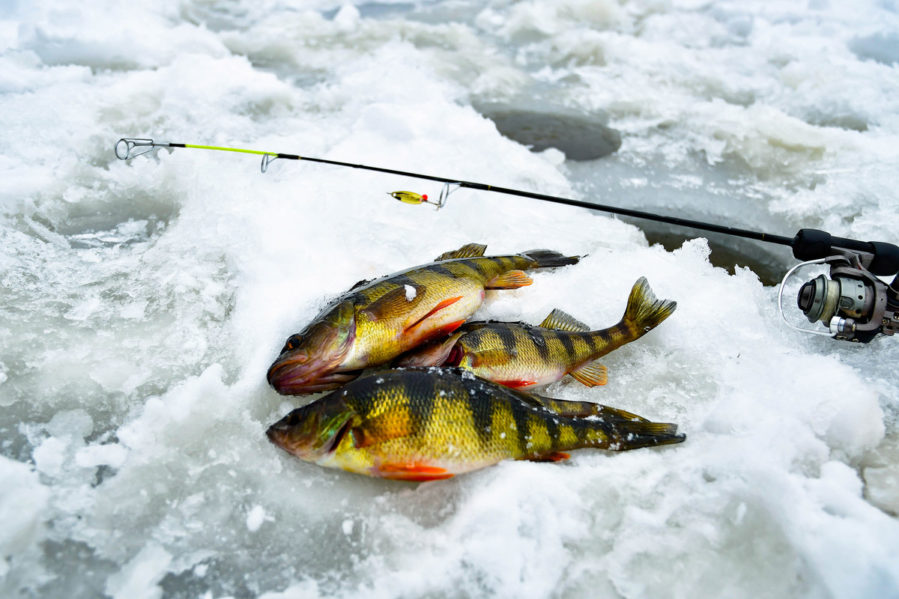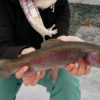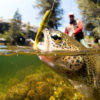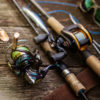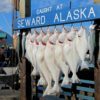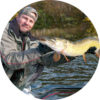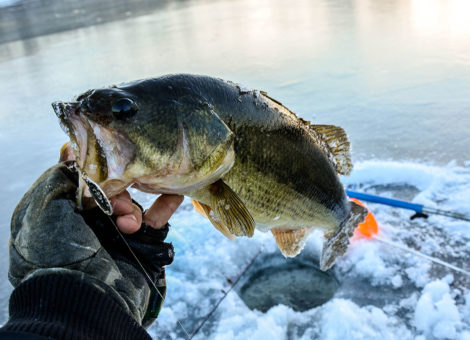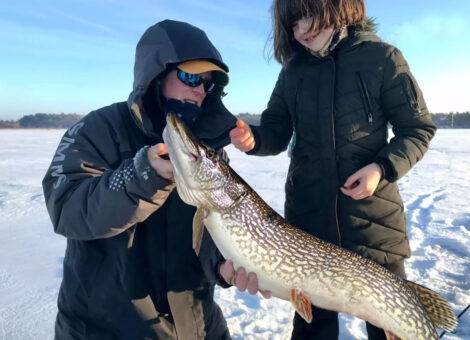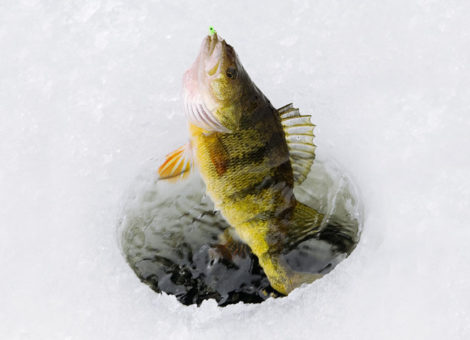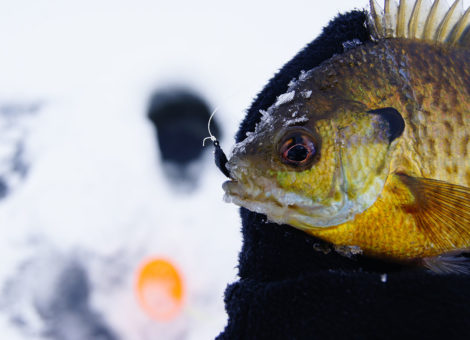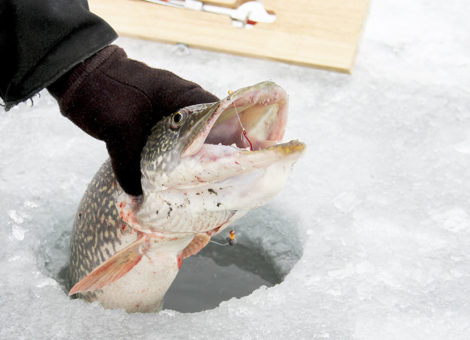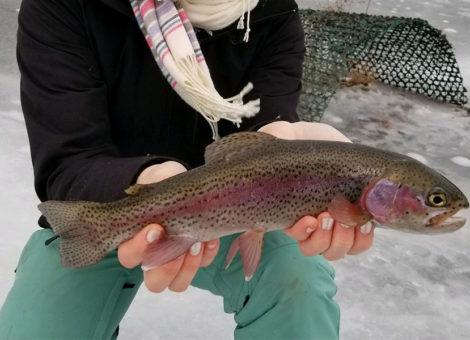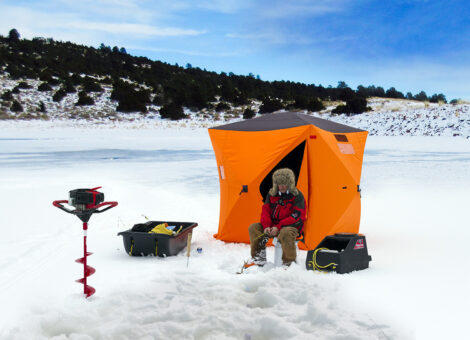Ice fishing offers a unique experience and the opportunity to catch a lot of fish – including the kind you can brag about to your friends and mount on your wall. Some people cringe at the idea of fishing outside in the winter, but it’s actually a good time to fish. While most freshwater fish are still looking for food in the winter, it’s not as plentiful. This works in your favor because the fish are hungry and less picky about what they eat.
- Finding a Location
- Drilling a Hole
- Ice Fishing Methods
- Ice Fishing Gear
- Ice Fishing with Live Bait
- Ice Fishing with Lures
- Safety Tips
- Pro Tips
Finding a Location
As you set out on your new adventure, the first thing you’ll want to do as beginner at ice fishing is find a good fishing spot. When you’re fishing in the spring or summer, mark the good spots on your fishfinder and try those same spots during the winter after the ice has formed.
If you didn’t mark any spots in the spring or summer, or you don’t know the lake very well, fish in the basin, a really steep shoreline, or gradual drop-off. Larger fish tend to swim next to steep shorelines and gradual drop-offs searching for their next meal. This is especially true in the early morning and around sunset. The best way to find these areas is to look at the contour lines using a GPS to map the the lake bed. The closer together the contour lines, the steeper the shoreline and drop-off.
As winter progresses and the ice thickens, you’ll need to change your strategy. During the colder months, target the deepest areas of the lake. The logic is simple – as it gets colder, most fish move to the deeper, warmer water. There are certain fish, however, that like to swim just below the ice. These include salmon and trout. If you’re fishing for either of those species, try setting some baits just underneath the ice.
If you’re a beginner, you’ll have more success if you look for schools of fish swimming near the bottom of the lake. Your local bait shop may also be able to give you some good tips.
If you’re not getting a bite at one fishing hole, drill several and move around. Also, try drilling holes and dropping your line at different depths. If you’re targeting a certain species of fish, placing your bait at the right depth can be key to getting a bite. During the winter, different fish species may forage at different depths in the water column.
The following table provides target depths and locations for target a different sports fish species when ice fishing.
| Fish species | Water depth/location |
|---|---|
| Northern Pike | Follow schools of bait fish at any depths. Typically deeper during mid-winter, anywhere from 5 to 15 feet near vegetation and rocky bottoms. |
| Smallmouth Bass | Smallmouth Bass are typically found on hard or rocky bottoms between 20 and 40 feet deep. |
| Largemouth Bass | Roam at different depths. Sometime found in shallows when there is vegetation. Target depth is 10 to 20 feet. |
| Walleye | Found in weed beds, drop-offs and reefs. During mid-winter found in deeper water near weeds, hard bottom spots and humps. |
| Yellow Perch | Feed on the bottom. Keep bait 1 to 2 feet off bottom. Found in 12 to 15 feet during early winter and move to 20 to 40 feet during mid-winter. Found on flats. |
| Crappie | Move to various depths throughout winter. Found 8 to 12 feet with vegetation during first ice. Found at 20 to 40 during mid-winter. Try different depths. |
| Rainbow Trout | Are typically found at shallower water level than other fish. Depths between 5 to 15 feet are ideal for targeting rainbow trout. |
| Lake Trout | Found in deeper waters throughout the entire winter. Target lake trout between 20 to 60 feet during winter months. |
| Kokanee (salmon) | Found from shallow to deeper waters in early and mid-winter depending on the lake. Target Kokanee from 10 to 80 feet when ice fishing. |
Drilling a Hole
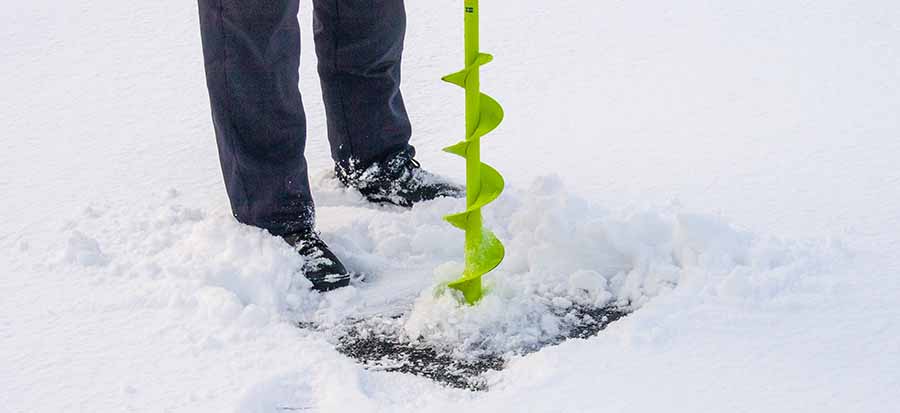
To get to the water, you’ll need an auger to cut a hole in the ice. You have three different options when it comes to augers: electric, gas and handheld. The cheapest of these is the handheld variety, which is also quiet and lightweight. Electric augers are easier to use and are also quiet, but you need to have an outlet nearby. Gas augers are the fastest option, but they’re noisy, heavy and more expensive than the other two options.
Once you’ve decided on your auger, it’s time to drill. The perfect-sized hole is about 8-10” – something big enough to pull a fish through, but small enough that people can’t fall into it. After drilling your hole, run over the area with an ice skimmer to get rid of any extra ice chunks. Now, you can start fishing – just remember to mark the hole so nobody will fall in after you leave.
Ice Fishing Methods
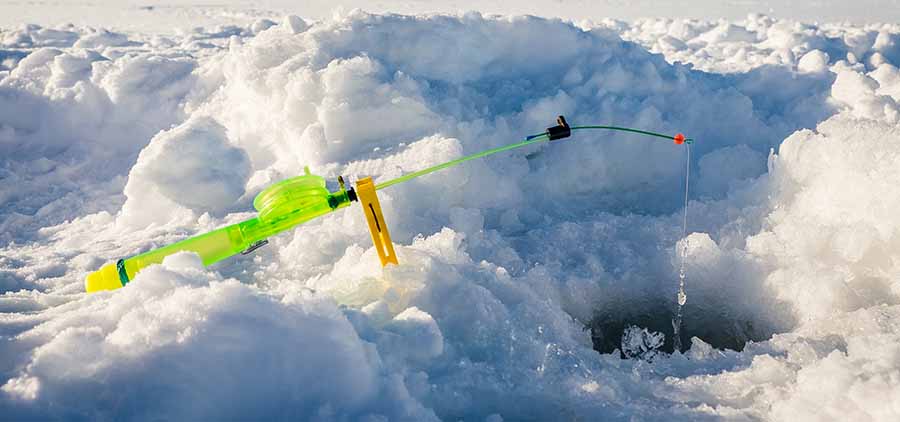
A fish’s metabolism slows down in cold weather, making them slower to respond. There are several ways to take advantage of a fish’s slow reaction time. Let’s go over the various techniques that work best for ice fishing.
1. Jigging with a Spring Bobber
The most popular and most enjoyable technique for ice fishing is jigging. When jigging, your best option is a spring bobber because they’re more sensitive than other bobbers. This allows you to easily see when you have a bite. Spring bobbers also make your bait appear more natural-looking because they make your jig movement more subtle.
2. Tip-ups
Another technique you can use when ice fishing is to fish with a tip-up. This is simply a spool of line that you set just under the ice so your live bait can hang underneath it. It keeps your bait at a certain depth and lets you see when you have a bite without having the hold the rod. Once you have a bite, it will trigger a flag to let you know something is on the line. Then, you can grab the line and pull it in with your hands.
Tip-ups allow you to fish a few different spots or lines at the same time without babysitting your line. The only bad thing about using a tip-up is that it isn’t as exciting as fishing without one because the tip-up is doing most of the work for you.
3. Spearfishing
Spearfishing can be a lot of fun, but it isn’t for everyone. You need a lot of skill, agility and concentration to be successful. You also want to check the state’s laws to see if there are any restrictions around which fish you can target.
Since you’ll be fishing right next to the surface, make sure you have a lot of chum to entice the fish into an area where you can reach them. You’ll also want to use a multi-pronged spear to improve your chances of success.
Ice Fishing Gear
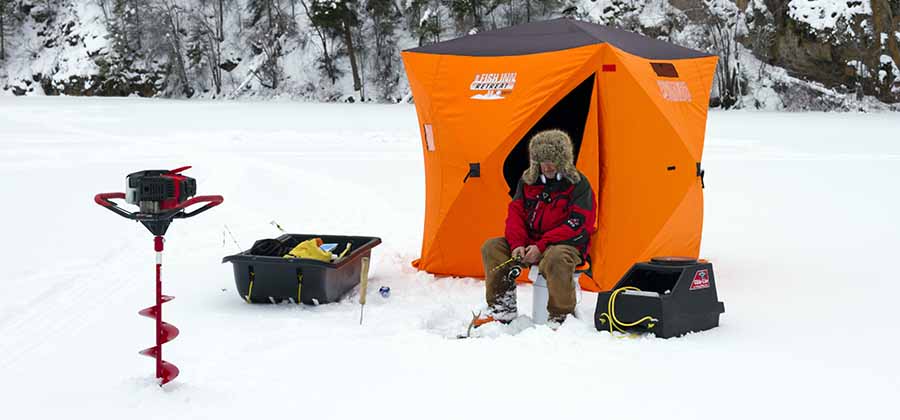
Since ice fishing is different than normal fishing, you’ll need to invest in some special equipment. In addition to the auger, spring bobber and tip-up listed above, here are a few additional things you’ll need:
Jigging Rod
First, you’ll need a medium-action, 28-inch jigging rod – this is the standard for ice fishing. You only need one of these, unless you plan on fishing a lot of lines at once.
Ice Fishing Line
Your best option is to choose fishing line made especially for ice fishing. This line is made to withstand cold water, be less visible and avoid abrasions. If you can’t find ice fishing line, you’ll want to choose the lightest line you can find, depending on the fish you’re targeting. When choosing a fishing line, look for fluorocarbon lines. These lines work well for ice fishing because they rarely tangle and are almost impossible to see in very cold water.
Leader
A leader is the line you attach to the end of your fishing line – the one you tie your lures or rig onto. Fish can’t see this line very well, so they often can’t tell it’s attached to your line. This increases your chances of catching a fish. Leaders also help protect your line from the sharp edges of the ice.
Ice Fishing Sled
You may think you don’t need a sled, but after you try carrying all your gear across the ice and snow, you’ll understand why they’re important. By using an ice sled, you can save yourself a lot of time and aggravation as you look for the perfect fishing spot. Make sure you choose a sturdy sled that is big enough to handle all your fishing gear.
Ice Fishing with Live Bait
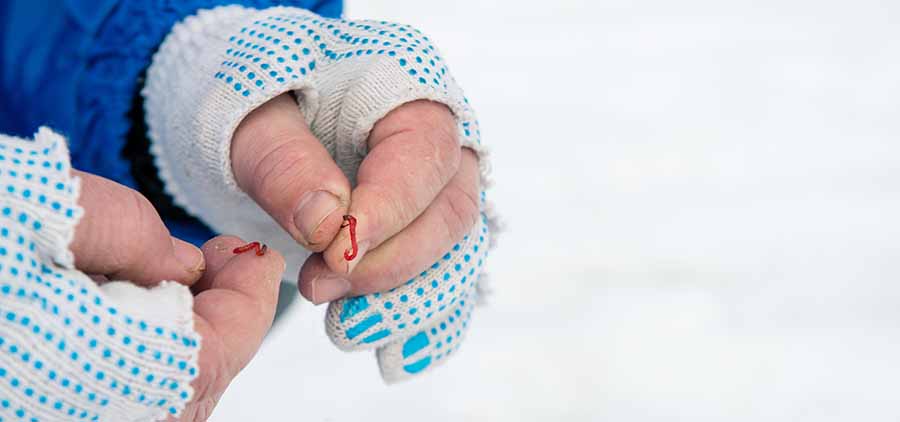
Live bait is a great option for ice fishing, but make sure it’s legal to use it in your area before you buy or catch it. If you can’t use live bait, you can always use cut bait. Here’s a breakdown of some of the best baits to try.
Minnows
When it comes to ice fishing, minnows are the bait most people choose because they work for so many different types of fish. You can use them to fish for crappie, walleye, perch and pike. Live minnows work the best, but you can also use dead ones.
Mealworms
Mealworms are another popular ice fishing bait – especially when fishing for panfish and trout. These little worms are easy to keep on your hook and work well as tips for your spoons and ice jigs.
Worms
Worms aren’t just for regular fishing – they work great for ice fishing as well. You can use the worm whole or rip it into pieces to use as tips on jigs and spoons. Walleye and trout in particular are very fond of worms.
Cut Bait
If you can’t use live bait, cut bait is a great option. Many people use cut bait for ice fishing because it stays on the hook and adds smell and flavor to your jig. The next time you cut up a fish to eat for dinner, save a few chunks to use as cut bait. Whitefish, perch and shad all work well as cut bait options.
Ice Fishing with Lures
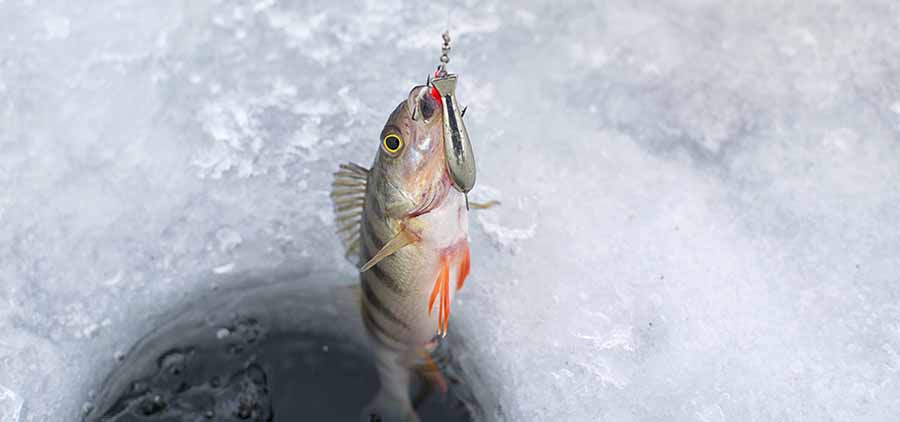
The best lure to use when ice fishing is the jig. They come in many different sizes, shapes and colors. Here are a few examples:
Simple Jigs
A simple jig is just a small hook with a metal jig head make of lead or tungsten. If you have the choice, choose tungsten – it sinks faster, and you can feel it at the end of your line.
Ice Spoons
An ice spoon is like a simple jig except that it has a larger, longer shape. Most people rig ice spoons with bait to make it look like wounded prey.
Tube Jigs
You can use a tube jig any time of year – including winter. A tube jig is a plastic tube with a small, weighted jig head. They don’t cost very much and work great for catching bass and panfish.
Swim Jigs
The most complicated of all jigs is the swim jig, which usually contains several treble hooks and looks something like a standard crankbait. Choose your swim jig based on the size of the fish you’re trying to catch.
Safety Tips
You can have a great time ice fishing, but make sure you’re being safe. Keep the following safety tips in mind when you head out on your fishing trip.
Ice Thickness
Always use caution when dealing with ice – never assume it will be safe. Things like springs, snow cover, rough fish, currents and temperature all have an effect on the ice. Also be aware that the thickness of ice changes in different spots. While it may be a few feet thick in one location, you can go a few yards away and find it’s much thinner. Never go more than 150 feet without checking the ice.
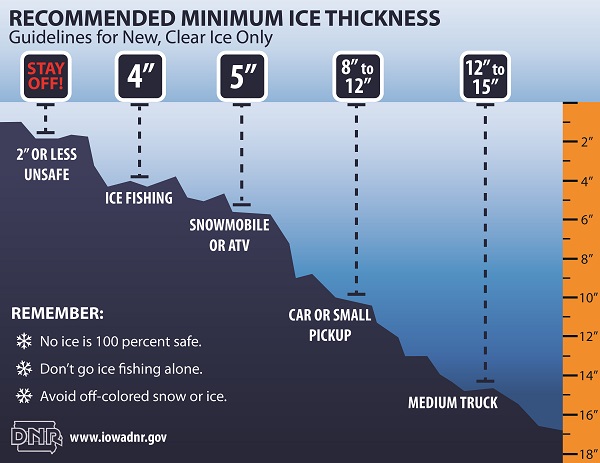
Ice thickness guidelines:
- 2” or less – don’t even attempt going on the ice
- 4” – you can walk or fish on it
- 5” to 7” – safe for an ATV or snowmobile
- 8” to 12” – can hold a car or small pickup
- 12” to 15” – safe for medium-sized trucks
You’ll notice that some ice is clear and other ice is white and looks like snow. Take note that the clear ice is about twice as strong as the white ice, so you’ll want to double the guidelines above when dealing with white ice. Also note that thickness is not the only indicator of the safety of ice, so always use extreme caution.
Check Ice Thickness
Here are some ways you can check the thickness of the ice:
- Ice Chisel. Ice chisels are pieces of metal with a flat, sharp blade on one end. To check the thickness with a chisel, simply stab the chisel into the ice, making a hole. Then, use a tape measure to determine the thickness of the ice.
- Ice Auger. Use your ice auger to drill a hole in the ice, then use a tape measure to determine the thickness.
- Cordless Drill. You can drill through ice very quickly using a cordless drill with a five-eighths inch wood auger bit. Once you’ve drilled your hole, use a measuring tape to determine the thickness of the ice.
Wear Safety Gear
When ice fishing, you want to wear a life vest under your other clothes in case you accidentally fall through the ice. You can also wear a floatation snowmobile suit if you happen to have one. It’s also smart to bring ice picks – either the homemade kind or ones you buy from a store. You’d be surprised at how hard it can be to pull yourself up onto the surface once you’ve fallen through the ice.
Refrain from Driving on Ice
Even though driving on ice sounds fun, it’s not a good idea. Try to avoid it whenever possible. If your only option is to drive over the ice, make sure you can get out of your vehicle quickly if it breaks through the ice. Drive with your windows down and talk to your passengers about an exit strategy should anything happen.
New Ice is Safest
The safest type of ice is new ice. It tends to be stronger than old ice because it’s had less time to be affected by the elements. You can usually walk on four inches of newly formed ice, but use extra caution if the ice is older.
Not All Ice is the Same
Not all ice is created equal. Ice that is further out can be stronger than ice that is next to the shore. And ice that has formed over currents and other types of flowing water can be very unsafe.
Also, when figuring how much weight ice can hold, you need to figure in the weight of any snow that may have accumulated on it. Because snow acts as insulation, it can also slow the rate at which ice freezes.
Pro Tips
- You don’t have to drill a hole to find fish. Simply use a flasher or depth finder to shoot a sonar signal through the ice and find the fish.
- Look for areas with a “sticky” bottom, meaning the mud is a gummy consistency that allows things to burrow into it. Early in the winter, you’ll have the best luck in shallow areas with lots of weeds; however, as it gets deeper into winter, you’ll find more fish in the deeper water. You can find these areas using a lake depth chart and looking for places that are between 15 to 30 feet deep where the contour lines are relatively far apart.
- Look at a contour map to see if you can find places with depressions that are 1 to 4 feet deep. These spots vary in width – some can even be bigger than a football field. Often overlooked by others, these areas attract fish because they tend to have warmer water.
- Move your jig. The more you move your jig, the more fish you’ll be able to attract. Shake your wrist using quick, short movements – this will make the jig vibrate. Do this while you raise and lower your rod slowly and smoothly. This will cause the head of the jig to go lower than the hook end, making it look like it’s bucking. And if you push your knot down to the hook end of the eyelet, the jig will appear to buck even harder. This should trick the fish into thinking it’s live prey and may even net you a bluegill, bass, walleye, perch or crappie.


